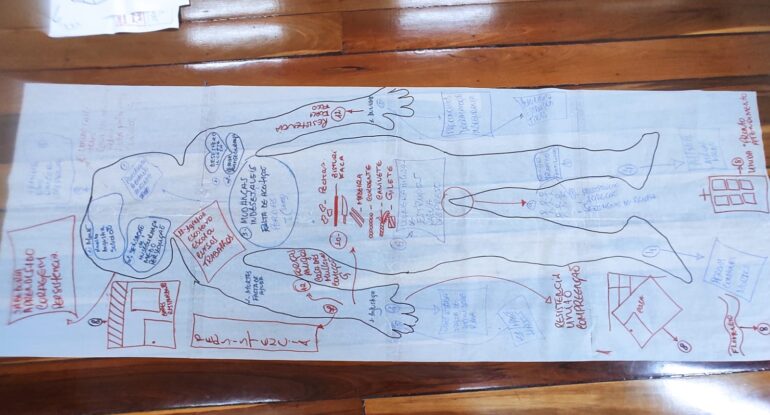‘Body-Territory mapping’ to produce counter-narratives of Maré
Blog Series: Methodological engagements for understanding violence against women and girls in cities
“My family is also from here, so my relationship with the territory is, I think, really historical, my grandmother came here very young, my mother too, so everything that I have today came from here”
Katia, is a 25-years-old black, cis woman from Maré who, like many other women in Maré, carries ancestral and territorial knowledge in her body, mobilising it on a daily basis to confront violence.
Likewise, Livia a 36-years-old black lesbian wrote on her body-map, on the area representing her feet, the phrase “our steps come from far away” in reference to black feminism in Brazil, embodying how her power and strength come from the collective and ancestral stories of resistance of women like her:
“I think that knowing that I’m not alone, that there is a history behind, in my family and people… Black people, black women, and black lesbians, and artists, and people that have to do with my education, beyond my family… to know that I am not alone, walking together, knowing that this step comes from very far away gives me the reason, and the desire not to give up… And what is it that takes me? My feet… literally the part of my body that carries me to places, right? And knowing that I am not alone, this gives me more strength, courage”
Livia reaffirms the centrality of collective and ancestral resistance knowledge. This knowledge is applied through practices involving their territories, their bodies, their territorial communities, and the city more broadly.
Previous stages of this research had identified many ways in which both bodies and territories are mobilized in contexts of gendered urban violence in Maré. Violations of territories affect women’s bodies, just as the violations of women’s bodies affect the territories. Similarly, practices of resistance to violence also mobilize bodies and uses of space. Therefore, a way was sought to explore further this ’continuum’ of violence and resistance that permeates body and territory.
We turned to feminist and decolonising geographical approaches that centres the body and embodiment in understanding women’s practices of resistance. Primarily, we drew upon and reconstructed a creative methodology based on the Latin American concept and method of ‘Body-Territory’.
Territorio Cuerpo-Tierra [Body-Earth Territory]or Cuerpo-Territorio [Body-Territory] is a concept and method that emerged from a political group of Maya-Xinka indigenous women in Guatemala and is central to the political project of territorial feminisms in Latin America, namely Colectivo Miradas Críticas del Territorio desde el Feminismo, Colectivo de Geografía Crítica de Ecuador, and Geobrujas. Having been adapted in a previous experience focusing on Latin-American women migrants responding to the challenges of the COVID-19 pandemic, this framework inspired us to create a participatory methodology of counter-mapping, co-produced between the teams in Brazil and the UK, focusing on women’s bodies as territories and on their collective knowledge about the spaces they inhabit.
Crafted from the embodied subjective viewpoint of women residents of the favelas of Maré and methodologically co-designed with our research partners, Casa das Mulheres da Maré, to serve their interests, a participatory ‘Body-Territory mapping’ was developed. The aim was to map the articulations of body and territory within resistance practices against gendered violence among women residents of Maré, during five co-designed workshops.
Art and technology were used, with audio-video production and videoconferencing as tools of immersion, methodological explanation and communication. An introductory video produced by Rosa Lopes-Heimer for the workshops, to explain and contextualise the Body-Territory proposal and show how the activity of mapping the body can be developed. The video was used to instigate the body-spatial imagination of the participants, preparing them to start the activity:
The participants were then invited to lie down on a sheet of paper the size of their body, and the researcher-facilitator drew their silhouettes with a pen, outlining their bodies. The participants were invited to answer questions concerning experiences of violence and their ways of confronting it by identifying certain emotions, feelings, sensations, memories, people and places in specific parts of their body-maps. They were also asked to think the territory of Maré and transpose many of the issues that emerged in their body maps to a territorial map.


Morro do Timbau)
Finally, they reflected on their experiences, allowing elaborations on their stories. A strength of this project as a whole has been to enable participants to tell and listen to each other’s stories, discussing their experiences in a collective way. This is primarily due to Casa das Mulheres’ important role supporting women in Maré, with the field researchers themselves being part of the team that monitors participants who signal any sociolegal or psychosocial demands during these research activities.
The resulting body and territorial maps are extremely effective in creating counter-narratives of Maré. Constructed from the point of view of women residents of Maré, they challenge homogeneous representations of Maré as a violent and dangerous place and the women residents as passive victims. In contrast, the maps help to qualify and complexify the nature of intersectional forms of violence experienced by these women and the strategic ways in which they mobilize their bodies and embody knowledge about their territories in their resistance practices. Interesting issue arose that were not captured in the more traditional interview and focus group methods. One key area was the role of engagement with nature as a form of coping and resistance, as indicated by Katia, placing the beach within her heart as her “first refuge” and explaining that being close to nature work as healing a practice (see her body map below). The ‘Body-Territory’ framework offers us this special sensibility that enables comprehensive understandings connecting body, nature and space as part of a whole, or in a continuum for promoting life, resistance and dignity.

